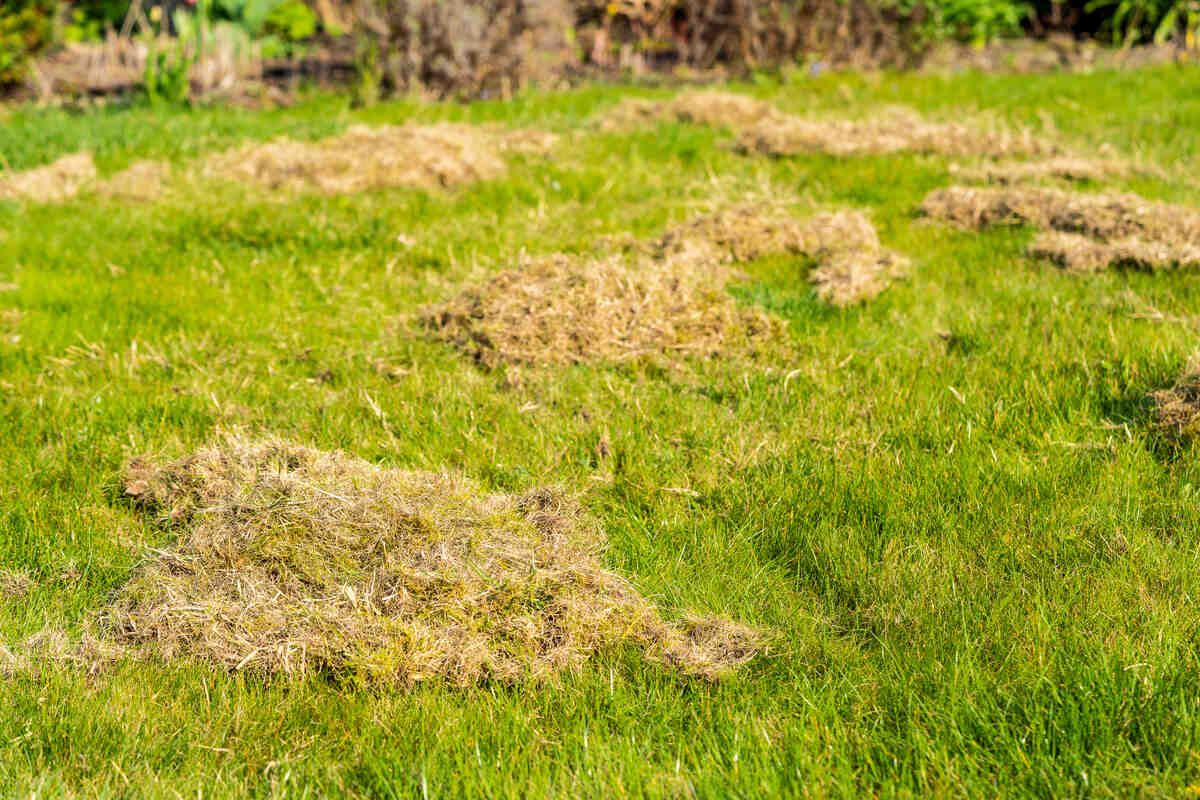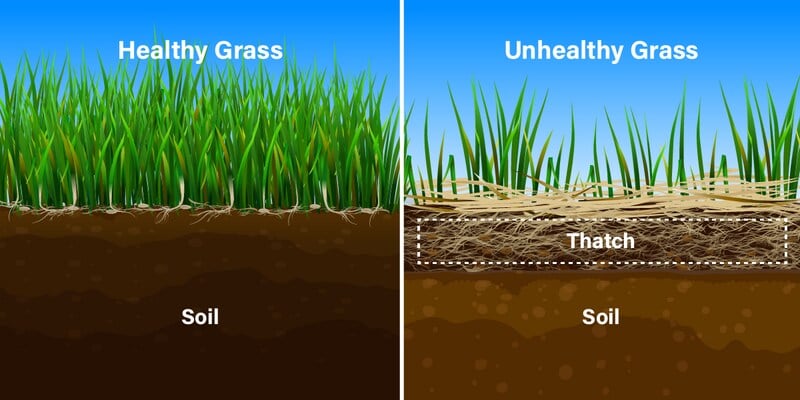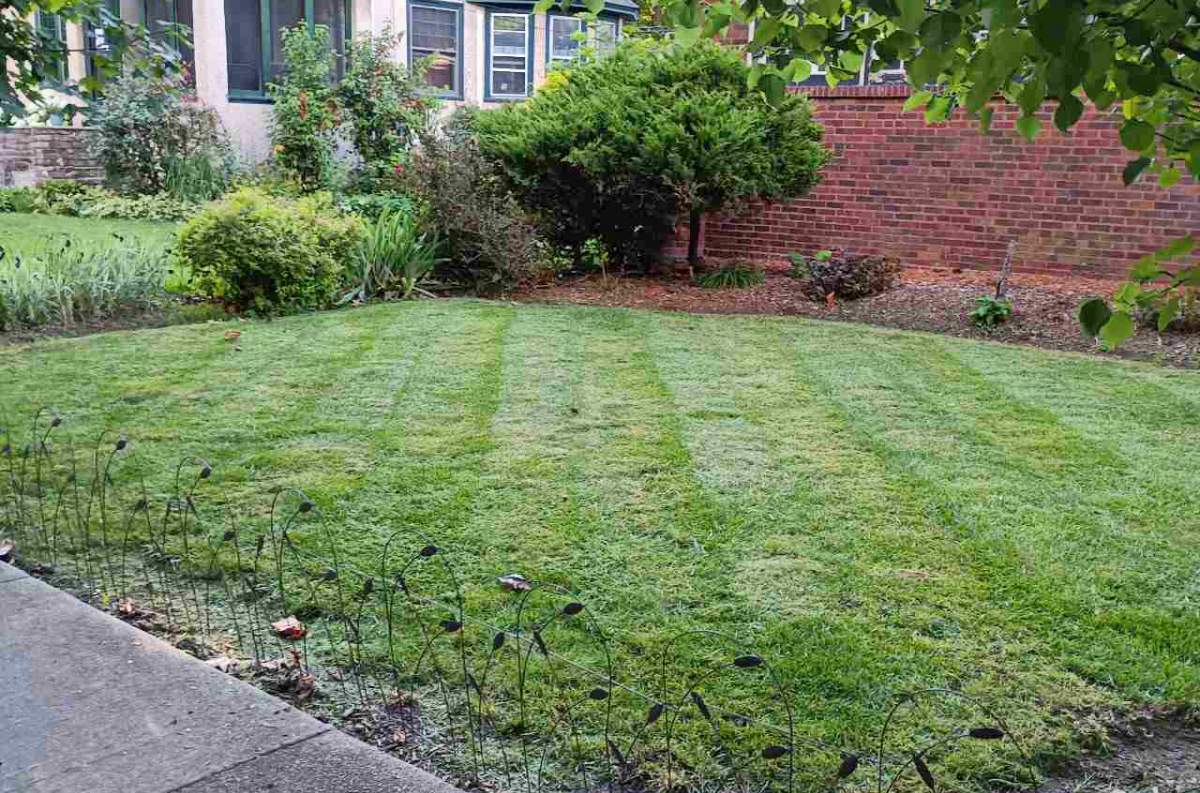
Dethatch your lawn at the start of your grass’s optimal growth period. The rule of thumb is to dethatch southern grasses in late spring to early summer and northern grasses in early spring or early fall.
We’ll also explain how air temperature and weather factor in, and hear from a specialist to learn how to fight excessive thatch.
Best Times to Dethatch by Grass Type and Region

Cool-Season (Northern Grasses)
The best time to dethatch a cool-season lawn in the northern part of the U.S. is late summer to early fall, starting in August. Though not ideal, you can dethatch as late as October or 3 to 4 weeks before the first frost. In the fall, weeds are not as virulent, and it’s also an ideal time to aerate and overseed.
The second best time to dethatch northern grasses is in the spring. However, when you dethatch in the spring (February to March), that beautiful, clean soil might invite stubborn weeds to pop up all around the lawn. If spring dethatching is the only option, apply a pre-emergent herbicide afterward.
Use these tips to ensure you choose a good time to dethatch your northern lawn:
- Fall: Wait until the heat subsides and your cool-season lawn starts to grow vigorously again. Dethatch no later than 3 to 4 weeks before the first frost.
- Spring: Dethatch after the second mow of the year, but at least a couple of weeks before air temperatures rise over 75 degrees Fahrenheit.
Warm-Season (Southern Grasses)
The best time of year to dethatch a warm-season lawn in the southern half of the country is late spring to early summer when the grass is actively growing and exposed to less heat and drought stress.
Southern grasses like Bermudagrass, Zoysia, and St. Augustine thrive between 80 to 95 degrees Fahrenheit, when the weather is ideal for dethatching. By dethatching early in the season, you set up your grass for a nice, carpet-like look.
But how early in the season can you dethatch your lawn? Wait a couple of weeks after the lawn greens up in spring, or, if it’s easier to remember, consider the second mow of the year as the earliest time to dethatch.
Avoid dethatching too close to hot, dry spells over 95 degrees Fahrenheit that can stress even the most warmth-loving summer grasses.
Transition Zone (Central Region With Both Grass Types)
Dethatch grasses in the transition zone (central part of the country) according to their peak growth period:
- Dethatch cool-season grasses, such as Kentucky bluegrass, perennial ryegrass and tall fescue, in late summer to early fall.
- Dethatch warm-season grasses, such as Zoysiagrass and Bermudagrass, in late spring to early summer.
Tip: If you have a mixed Bermuda and perennial ryegrass lawn, dethatch in late spring to early summer. This is when Bermuda is actively growing, and ryegrass starts to die back because of the heat. A thorough dethatching at this time helps remove the dead ryegrass and prepares the lawn for fall overseeding.
Best Time to Dethatch Based on Weather Conditions
The ideal time to dethatch your lawn is a day with mild weather that protects the grass from heat stress. If it rained recently, wait a few days so the soil can dry out a bit. Moist soil (neither wet nor dry) is ideal.
It’s even better if you can allow for 3 to 4 weeks between dethatching and stressful weather (high heat, first frost) for lawn recovery. That is usually how long the grass needs to completely bounce back from the mechanical stress.
Pro Tip: Dethatch early in the morning after the dew dries out. The cool morning temperatures make the work more comfortable, especially if you’re removing the thatch layer with a manual rake.
See Related: How to Dethatch Your Lawn
Other Conditions That Affect When to Dethatch

The frequency of dethatching depends on how easily thatch accumulates. Certain types of grass, lawn care practices, and soils contribute to thatch buildup and can lead to more frequent dethatching.
Thatch Thickness
If your lawn thatch is more than 1-inch thick, this is often a sign of a long-term problem. If you find this in your lawn, turfgrass specialists at the University of Missouri explain that mechanically dethatching overly thick thatch in a single session damages the living plants, and it’s better if done gradually.
“In such cases, moderate maintenance over 2 to 3 years may be more desirable than attempting complete removal in a single operation,” say the experts.
Type of Grass
- Perennial ryegrass and tall fescue produce thatch slowly, if at all, so you’ll only need to dethatch these lawns once every few years, if ever. Even so, it’s wise to always keep an eye on signs that indicate a thatch problem.
- Bermudagrass, Zoysia, St. Augustine, and Kentucky bluegrass produce many rhizomes and/or stolons (stems) that decay slowly and quickly add up to an overgrown thatch layer. Lawns with these grass species usually need to be dethatched yearly.
Lawns installed with sod are also more prone to thatch than seeded ones. Sod is often heavily fertilized in sod farms and will produce lots of organic matter. It also has a thick layer of roots that often have a hard time burying deep into a lawn’s dirt. Many roots remain shallow, dry out, and add to the thatch.
Note: It’s rare for a lawn to require dethatching two times a year, even with fast-growing hybrid Bermuda.
Lawn Maintenance
Too much TLC — excessive fertilizer, water, or chemical use — can boost the thatch layer, meaning you’ll need to dethatch more often.
Wendell Hutchens, assistant professor of turfgrass science at the University of Arkansas, explains: “Excessive applications of fertilizer and water will lead to thatch buildup and actually reduce plant health. Too much of a good thing can be a bad thing, and this is the case with fertilizer and irrigation on turfgrasses.”
Similarly, excessive fungicide or insecticide use can also increase thatch production by killing beneficial organisms in the soil that help break down organic matter.
Choosing the best time to dethatch your grass also involves coordinating with other tasks on your lawn care calendar. Dethatching frees the soil surface of debris and enhances aeration, overseeding, fertilization, and topdressing. It’s worthwhile to schedule them together to save time and maximize your lawn’s health.
Pro Tip: Dethatch and/or aerate before overseeding or fertilizing. Dethatching and aeration give grass seed, fertilizer, and topdressing better access to the soil layer.
See Related:
- How to Prevent Thatch in Your Lawn
- How to Aerate and Overseed Your Lawn
- When and How Often Should You Fertilize Your Lawn?
Soil Quality
Expect to dethatch more often if your lawn grows on heavy clay soil that is prone to compaction, sandy soil low in organic matter, or soil with unbalanced pH. Such soils don’t support earthworms and soil microbes that decompose the thatch and are among the common causes of thatch buildup.
According to Hutchens, “Soil pH can play a significant role in thatch buildup or decomposition. When soil pH levels are too acidic (below 5.5), then microbial activity is hindered, and thatch is allowed to build up more rapidly because there are fewer microbes to break down the thatch. The same problem can occur if soil pH is too high.”
See Related: Reasons Why Soil Testing Is Important for the Lawn
FAQ
Dethatching is an intensive lawn care treatment that can pierce blades, cut stems, and nick roots. Dethatching at the wrong time can compromise your grass’s recovery and cause extensive damage because the grass isn’t able to heal quickly. The overall stress on your turf leaves it more susceptible to pests and diseases and may even result in dead patches of grass.
While it depends on your grass type and local conditions, you can expect to see results at around 3 to 4 weeks after dethatching.
Wait 1 year (a full growing season after the installation) before dethatching a new lawn to ensure the turfgrass is properly established, with strong, healthy roots in the soil.
The Best Timing is Professional Timing

Lawn care pros know exactly when and how to remove the thatch from your lawn. Find a trusted lawn care company with LawnStarter, and give your grass the best chance for healthy and lush growth this season.
LawnStarter pros can also help prevent thatch buildup with top-notch lawn maintenance, including lawn mowing, leaf removal, aeration, and fertilization.
Sources:
- “What is Thatch?” University of Massachusetts Amherst.
- “Aerifying and Dethatching Lawns.” By Gregg Munshaw, Department of Plant and Soil Sciences. University of Kentucky.
- “Managing Thatch in Home Lawns.” By Peng Tian, MU Plant Diagnostic Clinic director and assistant Extension professor. University of Missouri.
- “Overseeding Florida Lawns for Winter Color.” by Laurie E. Trenholm, associate professor and turfgrass specialist, and J. Bryan Unruh, professor. University of Florida.
- “Thatch is the Enemy of Home Lawns.” by Frank Watson, county Extension coordinator. University of Georgia.
- Wendell Hutchens, assistant professor at the University of Arkansas, Fayetteville, AR. Personal Interview.
- “What is Thatch?” University of Massachusetts Amherst.
Main Image: Dead grass left over by a mechanical lawn dethatcher. Photo Credit: fotomolka / Adobe Stock